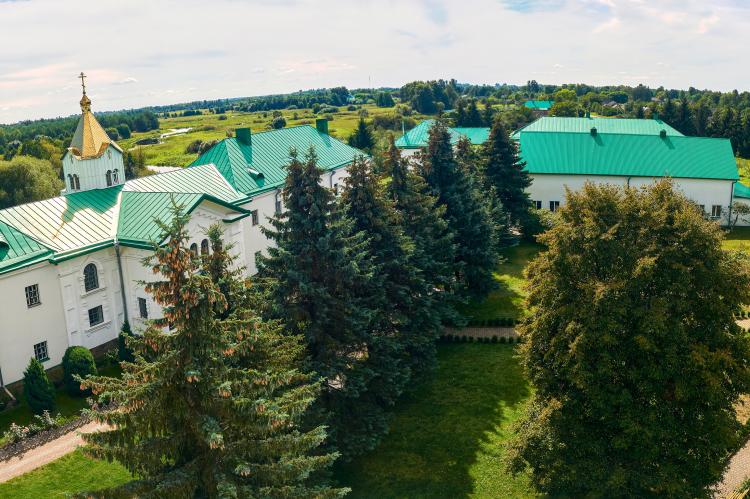The history of our region hides many mysteries. Unfortunately, many of its pages will remain unread due to a number of circumstances. However, it is good that there are still people who gather information bit by bit so that we can at least look out of the corner of history and learn about those who created it.
On September 3-4, in the framework of the project "Prince Sanguszko’s Family By-Ways Virtual Tour – let’s reveal new pages of shared Ukrainian and Polish history", which is implemented with the financial support of the European Union under the Cross-Border Cooperation Program Poland - Belarus - Ukraine 2014-2020 European Neighborhood Instrument, promotional tour of places included in the cross-border tourist route "By the way of the princely family Sangushkiv".
The route geographically covers the territory of the Ukrainian-Polish border: Lutsk - Kovel - the village of Myltsi (Starovyzhiv district) - Kamin-Kashyrsky - the village of Yarevyshche (Starovyzhiv district) - Volodymyr-Volynsky - Wlodava - Kiyany - Lubartiv - Rudno - Lublin - Krasnychyn-Dub.
The total cost of the project was € 44,750.68, with EU co-financing € 40,271.14. The project partners were the non-government organisation "Volyn Regional Initiatives Centre" from Ukraine and the the Association of Local Governments of Euroregion Bug from the of Poland.
"This project is another page in the history not only of our non-government organisation, the "Volyn Regional Initiatives Centre", but also of the cross-border region, which covers the Volyn region and the Lubelskie voivodeship," said project manager Natalia Krolik. - We have quite a lot of experience in implementing economic and cultural projects. But we decided to try our hand in the historical direction, because there are many unexplored pages of our common history with the Poles. So we set out to study the Sangushki family, which made a significant contribution to the development of Volynska oblast and the Lubelskie voivodeship"
"The project is designed to attract as many domestic and foreign tourists to our region. In order to disseminate information, a promotional tour was organized, - explains the executive director of the NGO " Volyn Regional Initiatives Centre" Oleg Shcherba. - I think this route will find connoisseurs among history buffs. Maybe it will allow us to look at our tourist attractions from a slightly different angle. "
"As part of the tour, we had to see the sights of Volyn and Lublin," said Ms. Natalia. - But due to the coronavirus pandemic and quarantine, the plans had to be adjusted. So, almost simultaneously with our Polish partners, we visit the sights: we are in the territory of Volyn, they are in the territory of the Lublin region. And then through an online meeting we exchange impressions and experiences. "IA Volyn News also had the opportunity to travel along the paths of the famous Sangushkiv princes in Volhynia.
The journey from the city of Kovel railwaymen began. Researchers say that Kovel is an ancient city directly connected with Sangushki. Unfortunately, none of the monuments related to this princely family have survived here. Although there is historical evidence that the Sangushkas owned Kovel, there have been long disputes over ownership between the various branches of the family.
"In the first half of the 16th century, the Sangushkiv family was divided into three lines: Kovel, Kashira and Nesukhoizh. The struggle between the representatives of these lines lasted until Queen Bona, the wife of Sigismund the Old, exchanged possessions with one of the Sangushki, - said the project expert, researcher and journalist Serhiy Naumuk. - She took possession of Kovel and the surrounding villages, and Sangushki - viitovstvo in Lutsk and income from it and possession in modern Belarus. Thus came peace. "
Our next stop was a special place for Orthodox believers - St. Nicholas Monastery in the village of Miltsy in Starovyzhiv region.
The monastery greeted travelers with graceful silence, quiet prayer and the aroma of incredibly beautiful roses. It seems that even the hourglass here is special - so filled with something important and unhurried. The inhabitants of the monastery also seem respectful and unhurried.
When you go up to the towering bell tower, where the bells are open to all four winds, the beauty that surrounds it is truly breathtaking.
Hierodeacon Ignatius volunteered for us as a guide. He says he has such obedience that day.
"The first mention of our monastery dates back to 1309, although no one knows for sure how long it has been operating. According to legend, in 1240 monks lived in Verbka near Kovel. During the Mongol-Tatar invasion, they climbed the Turia River to save their lives and monastic traditions and fell in love with these places. And according to another version, they joined the monastic tradition, which was already here, - Ignatius told us. "In the 16th century, the founders of the monastery were the princes of Sangushka and they helped those monks who lived here at that time."
St. Nicholas Church was built at the expense of the Sangushki princes.
"This is the oldest architectural Orthodox monument in the Starovyzhiv region," says Ignatius. - In 1542 a stone was laid, and in 1549 the church was completely turned over. It was founded by Fedor Andreevich Sangushko.
In the altar there is still a fresco depicting the Virgin. It was accidentally discovered in the late 90's during the restoration of the monastery by masters. After upholstering the old plaster, in the altar of the temple they came across an old wall painting, which was kept in the Upper Place. According to one version, when the monastery was captured by the Uniates, one of those who sympathized with the Orthodox, built a niche with a fresco.
In 1947, the monastery was transformed into a vocational school, and in the Transfiguration Church, built in the XIX century, there is a club. Then the monastery was reformatted into a boarding house for the elderly. In the Nikolaev temple arranged a dining room.
"Well, we can thank you at least for not demolishing the building to the ground. And when the first monks came here in the early 90s of the last century, they rebuilt the monastery not out of nowhere, ”Ignatius smiles.
When the St. Nicholas Church was being restored, the remains of six people, as well as the remains of monks' clothes and shoes, were found under the spud. According to one version, they were monks, according to another - representatives of the Sangushki family, who commanded to bury themselves in the monastery, because they were its founders. The monks reburied them in the cemetery on the territory of the monastery in a mass grave.
In the place of honor in the church is the image of St. Nicholas, in which a cross-reliquary and a part of the relics of the saint are mounted.
"Anyone who does not have the opportunity to go to the city of Bari in Italy to pray at the relics of the saint can do so here. On the feast days of the throne, the glass on the icon is raised and people have the opportunity to lie on the cross, - added the hierodeacon. "Besides, in this cross there are also relics of St. Kuksha of Odessa and St. Tikhon."
And we travel further… Of course, Polissya roads are another test of strength. But can it stop the curious and the brave?
In Kamen-Kashirsky, travellers were welcomed at the National Museum of Local Lore, which is one of the richest in exhibits in the region. In particular, we were able to see a fragment of the altar from the church of the Dominican Order. And here is a unique harmonium, which may also have stood in the church.
And then we travelled to the chapel of the Dominican church. The first thing that struck me were the chubby centuries-old oaks, which, like guards, stretched out around the chapel, supporting the sky with their crowns.
In 1637, Volyn voivode Adam Sangushko and his wife Kateryna Ukhanska founded a Dominican monastery. There is also information that Sangushko made a donation in 1653.
This monastery operated until 1832, when the tsarist authorities closed it. Since then, the church was only a parish.
According to Mykola Teodorovych, in 1858 it was built by parishioners. Although the director of the local museum Natalia Pas believes that it was a rebuilt church, because it already existed at that time.
In Soviet times, there was a woodworking shop, and the chapel itself was used as a dryer. Today it is an architectural monument under protection.
The next point of our route is the village of Yarevyshche in the Starovyzhiv region. This unique settlement, stretching for about 18-20 km, was mentioned in the thirteenth century as the city of Paradise or Paradise. It was founded by Prince Vasilko, who was travelling from Lyuboml to Kamyanets (this is modern Belarus).
The Sangushkiv Monastery in this village was mentioned in 1444, when Prince Andriy Sangushko provided it with land where you could dig ponds, fish, and hold a fair.
Nowadays, the name of the Monastyryshche tract reminds of the glorious past, where a few years ago researchers excavated the remains of the foundation of a capital building made of glove bricks and found samples of 15th century pottery, coins and a bronze ring. And also - a cross, which is believed to stand on the site of the chronicle settlement.
In Volodymyr-Volynskyi, two monuments related to the Sangushkiv family have survived to the present day. These are St. Basil's Rotunda Church and the Assumption Cathedral.
According to legend, after the victory over the tribe of white Croats, Prince Vladimir stopped with the army in the city of Vladimir. He ordered each of the soldiers to bring one brick, and it was as if a church had been built in one day. And since in baptism the Grand Duke, accepting Orthodoxy, took the name Vasily, the church was named Vasylivska. Of course, this is just a beautiful legend. However, it adds a special charm to this unique temple.
"St. Basil's Rotunda Church is known for being a unique church built in the shape of a flower with eight petals," said Serhiy Naumuk. "It is interesting for us because there is a documentary mention that in 1523 Prince Vasyl Sangushko was named the patron saint of this church."
Historians suggest that the prince, as a noble and not poor man, could at his own expense to improve the condition of the temple, which at that time was not in the best condition. It is also the first written mention of St. Basil's Church. And in 1588 it is mentioned as a brick.
This church still preserves a shrine - the icon of the Virgin Hodegetria, dating from the XVI century. This image survived a fire that broke out in the 19th century in the Church of the Entry into the Church of the Mother of God, which stood not far from St. Basil's Church. Parishioners consider the icon miraculous.
The Assumption Cathedral in Volodymyr-Volynskyi was built by Prince Mstislav Izyaslavovych in 1160. However, it was destroyed by Tatar attacks, the cart suffered several major fires and was rebuilt several times. It was finally rebuilt at the end of the 19th century in the pseudo-Byzantine style.
In fact, the cathedral impresses with its grandeur.
And the Cathedral of the Nativity of Christ is given a remarkable spirit of mystery by a dungeon in which once, perhaps, Orthodox believers hid from enemies and prayed to great princes.
We will add that soon the joint cross-border route "By the ways of the princely family Sangushkiv" will be available on the website and in the mobile application, and also the tourist guide of the same name will be issued. So history buffs will be able to travel the paths taken by the princes of Sangushka, both online and live.
Oksana GOLOVIY
Photo by Alexander DURMANENKO
Source: "Volyn News"

































